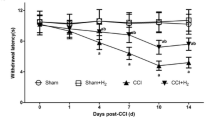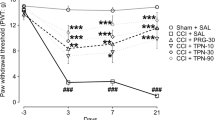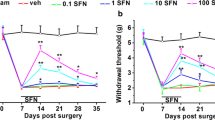Abstract
Recent studies have emphasized the contribution of neuroinflammation and oxido-nitrosative stress to neuropathic pain. Both, heme oxygenase (HO)-1 and carbon monoxide (CO) play an important role in regulating free radical generation and inflammation. Herein, we investigated the role of HO-1/CO pathway, by using hemin, a selective HO activator, and CO-releasing molecule (CORM)-2, a CO-releasing agent, in rat sciatic nerve chronic constriction injury (CCI)-induced neuropathic pain. CCI rats exhibited full development of behavioral hypersensitivity symptoms, including cold allodynia, mechanical and thermal hyperalgesia and also exhibit of a significant increase in spinal cord pro-inflammatory cytokines (TNF-α and IL-1β) and oxido-nitrosative stress markers, both in spinal cord and ipsilateral sciatic nerve homogenate. Spinal (10 and 30 μg/rat, intrathecal (i.t.)), but not systemic (5 and 10 mg/kg, subcutaneous (s.c.)), administration of hemin for 14 days significantly prevented the development of behavioral hypersensitivity. Further, simultaneous administration of hemin via spinal (10 μg/rat, i.t.) and systemic (5 mg/kg, s.c.) routes led to a more pronounced inhibition of the development of behavioral hypersensitivity. Further, administration of CORM-2 (1 and 5 mg/kg, s.c.), dose-dependently and most effectively, prevented the development of behavioral hypersensitivity. Both hemin and CORM-2 produced ameliorative beneficial effects that paralleled with the extent of reduction of oxido-nitrosative stress and pro-inflammatory cytokines. Also, hemin and CORM-2 significantly improved the levels of HO-1 and activity of anti-oxidant enzymes such as superoxide dismutase and catalase. Thus, it may be concluded that chronic pharmacological activation of HO-1/CO pathway may prevent the development of behavioral symptoms of neuropathic pain, through an activation of anti-inflammatory and anti-oxidant mechanisms.





Similar content being viewed by others
References
Abraham NG, Kappas A (2008) Pharmacological and clinical aspects of heme oxygenase. Pharmacol Rev 60:79–127
Agarwal CS, Anand M, Arjundas D, Baheti DK, Balaji V, Banerjee T, Joshi M, Prasannakumar K, Mehrotra R, Mohan V, Rais N, Roy T, Sharda A, Sinha B, Sridharan R, Srikanta, Srinivasa R, Srinivasan AV, Sule N, Talwalkar P, Viswanathan V, Yograj S (2008) Burden of neuropathic pain in Indian patients attending urban, specialty clinics: results from a cross sectional study. Pain Pract 8(5):362–378
Ahanger AA, Prawez S, Kumar D, Prasad R, Amarpal, Tandan SK, Kumar D (2011) Wound healing activity of carbon monoxide liberated from CO-releasing molecule (CO-RM). Naunyn Schmiedebergs Arch Pharmacol 384(1):93–102
Alam J, Stewart D, Touchard C, Boinapally S, Choi AM, Cook JL (1999) Nrf2, a Cap'n'Collar transcription factor, regulates induction of the heme oxygenase-1 gene. J Biol Chem 274(37):26071–26078
Benallaoua M, François M, Batteux F, Thelier N, Shyy JY, Fitting C (2007) Pharmacologic induction of heme oxygenase 1 reduces acute inflammatory arthritis in mice. Arthritis Rheum 56:2585–2594
Bennett GJ, Xie YK (1988) A peripheral mononeuropathy in rat that produces disorders of pain sensation like those seen in man. Pain 33:87–107
Carvalho PG, Branco LG, Panissi CR (2011) Involvement of the heme oxygenase-carbon monoxide-cGMP pathway in the nociception induced by acute painful stimulus in rats. Brain Res 1385:107–113
Chen P, Sun B, Chen H, Wang G, Pan S, Kong R, Bai X, Wang S (2010) Effects of carbon monoxide releasing molecule-liberated CO on severe acute pancreatitis in rats. Cytokine 49(1):15–23
Davis M (2007) What is new in neuropathic pain? Support Care Cancer 15:363–372
Dray A (2008) Neuropathic pain: emerging treatments. Bri J Anaesth 101:48–58
Egea J, Rosa AO, Lorrio S, del Barrio L, Cuadrado A, López MG (2009) Haeme oxygenase-1 overexpression via nAChRs and the transcription factor Nrf2 has antinociceptive effects in the formalin test. Pain 146(1–2):75–83
Gao X, Kim HK, Chung JM, Chung K (2007) Reactive oxygen species (ROS) are involved in enhancement of NMDA-receptor phosphorylation in animal models of pain. Pain 131:262–271
Grangeiro NM, Aguiar JA, Chaves HV, Silva AA, Lima V, Benevides NM, Brito GA, da Graça JR, Bezerra MM (2011) Heme oxygenase/carbon monoxide-biliverdin pathway may be involved in the antinociceptive activity of etoricoxib, a selective COX-2 inhibitor. Pharmacol Rep 63(1):112–119
Guedes RP, Bosco LD, Teixeira CM, Araújo AS, Llesuy S, Belló-Klein A, Ribeiro MF, Partata WA (2006) Neuropathic pain modifies antioxidant activity in rat spinal cord. Neurochem Res 31:603–609
Hargreaves K, Dubner R, Brown F, Flores C, Joris J (1988) A new and sensitive method for measuring thermal nociception in cutaneous hyperalgesia. Pain 32:77–88
Hu P, Bembrick AL, Keay KA, McLachlan EM (2007) Immune cell involvement in dorsal root ganglia and spinal cord after chronic constriction or transection of the rat sciatic nerve. Brain Behav Immun 21:599–616
Innamorato NG, Lastres-Becker I, Cuadrado A (2009) Role of microglial redox balance in modulation of neuroinflammation. Curr Opin Neurol 22(3):308–314
Jadhav A, Torlakovic E, Ndisang JF (2008) Interaction among heme oxygenase, nuclear factor-kappaB, and transcription activating factors in cardiac hypertrophy in hypertension. Hypertension 52(5):910–917
Kaur S, Bijjem KR, Sharma PL (2011) Anti-inflammatory and antihyperalgesic effects of the combination of ibuprofen and hemin in adjuvant-induced arthritis in the Wistar rat. Inflammopharmacology 19(5):265–272
Kim HK, Park SK, Zhou JL, Taglialatela G, Chung K, Coggeshall RE, Chung JM (2004) Reactive oxygen species (ROS) play an important role in a rat model of neuropathic pain. Pain 111(1–2):116–124
Ledeboer A, Sloane EM, Milligan ED, Frank MG, Mahony JH, Maier SF, Watkins LR (2005) Minocycline attenuates mechanical allodynia and proinflammatory cytokine expression in rat models of pain facilitation. Pain 115:71–83
Lee TS, Chau LY (2002) Heme oxygenase-1 mediates the anti-inflammatory effect of interleukin-10 in mice. Nature Medicine 8:240
Levy D, Zochodne DW (1998) Local nitric oxide synthase activity in a model of neuropathic pain. Eur J Neurosci 10:1846–1855
Li B, Lee D-S, Jeong G-S, Kim Y-C (2012) Involvement of heme oxygenase-1 induction in the cytoprotective and immunomodulatory activities of 6,4′-dihydroxy-7-methoxyflavanone in murine hippocampal and microglia cells. Eur J Pharmacol 674:153–162
Li X, Clark JD (2000) The role of heme oxygenase in neuropathic and incisional pain. Anesth Analg 90(3):677–682
Maines MD (1997) The heme oxygenase system: a regulator of second messenger gases. Annu Rev Pharm Toxicol 37:517–554
Mancuso C (2004) Heme oxygenase and its products in the nervous system. Antioxid Redox Signal 6(5):878–887
McDermott AM, Toelle TR, Rowbotham DJ, Schaefer CP, Dukes EM (2006) The burden of neuropathic pain: results from a cross-sectional survey. Eur J Pain 10(2):127–135
Meregalli C, Canta A, Carozzi VA, Chiorazzi A, Oggioni N, Gilardini A, Ceresa C, Avezza F, Crippa L, Marmiroli P, Cavaletti G (2010) Bortezomib-induced painful neuropathy in rats: a behavioral, neurophysiological and pathological study in rats. Eur J Pain 14:343–350
Merskey H, Bogduk N (eds) (1994) Classification of chronic pain: descriptions of chronic pain syndromes and definitions of pain terms, 2nd edn. IASP, Seattle
Mika J, Osikowicz M, Makuch W, Przewlocka B (2007) Minocycline and pentoxifylline attenuate allodynia and hyperalgesia and potentiate the effects of morphine in rat and mouse models of neuropathic pain. Eur J Pharmacol 560(2–3):142–149
Milligan ED, Sloane EM, Langer SJ, Hughes TS, Jekich BM, Frank MG, Mahoney JH, Levkoff LH, Maier SF, Cruz PE, Flotte TR, Johnson KW, Mahoney MM, Chavez RA, Leinwand LA, Watkins LR (2006) Repeated intrathecal injections of plasmid DNA encoding interleukin-10 produce prolonged reversal of neuropathic pain. Pain 126(1–3):294–308
Milligan ED, Watkins LR (2009) Pathological and protective roles of glia in chronic pain. Nat Rev Neurosci 10:23–36
Misra HP, Fridovich I (1972) The role of superoxide anion in the autoxidation of epinephrine and a simple assay for superoxide dismutase. J Biol Chem 247:3170–3175
Moalem G, Tracey DJ (2006) Immune and inflammatory mechanisms in neuropathic pain. Brain Res Brain Res Rev 51:240–264
Motterlini R, Clark JE, Foresti R, Sarathchandra P, Mann BE, Green CJ (2002) Carbon monoxide-releasing molecules: characterization of biochemical and vascular activities. Circ Res 90:E17–E24
Motterlini R, Otterbein LE (2010) The therapeutic potential of carbon monoxide. Nat Rev Drug Discov 9:728–743
Naik AK, Tandan SK, Kumar D, Dudhgaonkar SP (2006) Nitric oxide and its modulators in chronic constriction injury-induced neuropathic pain in rats. Eur J Pharmacol 530:59–69
Nascimento CG, Branco LG (2009) Antinociception synergy between the peripheral and spinal sites of the heme oxygenase-carbon monoxide pathway. Braz J Med Biol Res 42(1):141–147
Niehius WG Jr, Samuelsson B (1968) Formation of malonaldehyde from phospholipid arachidonate during microsomal lipid peroxidation. Eur J Biochem 6:126–130
Otterbein LE, Bach FH, Alam J, Soares M, Tao LH, Wysk M, Davis RJ, Flavell RA, Choi AM (2000) Carbon monoxide has anti-inflammatory effects involving the mitogen-activated protein kinase pathway. Nat Med 6:422–428
Padi SSV, Kulkarni SK (2004) Differential effects of naproxen and rofecoxib on the development of hypersensitivity following nerve injury in rats. Pharmacol Biochem Behav 79:349–358
Padi SSV, Kulkarni SK (2008) Minocycline prevents the development of neuropathic pain, but not acute pain: possible anti-inflammatory and antioxidant mechanisms. Eur J Pharmacol 601:79–87
Paine A, Eiz-Vesper B, Blasczyk R et al (2010) Signaling to heme oxygenase-1 and its anti-inflammatory therapeutic potential. Biochem Pharmacol 80:1895–1903
Park ES, Gao X, Chung JM, Chung K (2006) Levels of mitochondrial reactive oxygen species increase in rat neuropathic spinal dorsal horn neurons. Neurosci Lett 391:108–111
Perkins NM, Tracey DJ (2000) Hyperalgesia due to nerve injury: role of neutrophils. Neuroscience 101(3):745–757
Pruessener JC, Kirschbaum C, Meinlschmid G, Hellhammer DH (2003) Two formulas for computation of the area under the curve represent measures of total hormone concentration versus time-dependent change. Psychoneuroendocrinol 28:916–931
Raghavendra V, Tanga F, DeLeo JA (2003) Inhibition of microglial activation attenuates the development but not existing hypersensitivity in a rat model of neuropathy. J Pharmacol Exp Ther 306:624–630
Rosa AO, Egea J, Lorrio S, Rojo AI, Cuadrado A, López MG (2008) Nrf2-mediated haeme oxygenase-1 up-regulation induced by cobalt protoporphyrin has antinociceptive effects against inflammatory pain in the formalin test in mice. Pain 137(2):332–339
Sandkuhler J (2009) Models and mechanisms of hyperalgesia and allodynia. Physiol Rev 89:707–758
Sastry KV, Moudgal RP, Mohan J, Tyagi JS, Rao GS (2002) Spectrophotometric determination of serum nitrite and nitrate by copper-cadmium alloy. Anal Biochem 306(1):79–82
Sinha AK (1972) Colorimetric assay of catalase. Anal Biochem 47:389–394
Steiner AA, Branco LGS, Cunha FQ, Ferreira SH (2001) Role of the haeme oxygenase/carbon monoxide pathway in mechanical nociceptor hypersensitivity. Br J Pharmacol 132:1673–1682
Syapin PJ (2008) Regulation of haeme oxygenase-1 for treatment of neuroinflammation and brain disorders. Br J Pharmacol 155:623–640
Tai YH, Tsai RY, Lin SL, Yeh CC, Wang JJ, Tao PL (2009) Amitriptyline suppresses neuroinflammation-dependent interleukin-10-p38 mitogen-activated protein kinase-heme oxygenase-1 signaling pathway in chronic morphine-infused rats. Anesthesiology 110(6):1379–1389
Thacker MA, Clark AK, Marchand F, McMahon SB (2007) Pathophysiology of peripheral neuropathic pain: immune cells and molecules. Anesth Analg 105:838–847
Tsuda M, Shigemoto-Mogami Y, Koizumi S, Mizokoshi A, Kohsaka S, Salter MW, Inoue K (2003) P2X4 receptors induced in spinal microglia gate tactile allodynia after nerve injury. Nature 424(6950):778–783
Tsuda M, Tozaki-Saitoh H, Masuda T, Toyomitsu E, Tezuka T, Yamamoto T, Inoue K (2008) Lyn tyrosine kinase is required for P2X(4) receptor upregulation and neuropathic pain after peripheralnerve injury. Glia 56:50–58
Vallejo R, Tilley DM, Vogel L, Benyamin R (2010) The role of glia and the immune system in the development and maintenance of neuropathic pain. Pain Pract 10(3):167–184
Watkins LR, Hutchinson MR, Milligan ED, Maier SF (2007) “Listening” and “talking” to neurons: implications of immune activation for pain control and increasing the efficacy of opioids. Brain Res Rev 56:148–169
Wilkinson WJ, Kemp PJ (2011) The carbon monoxide donor, CORM-2, is an antagonist of ATP-gated, human P2X4 receptors. Purinergic Signal 7(1):57–64
Yaksh TL, Rudy TA (1976) Chronic catheterization of the spinal subarachnoid space. Physiol Behav 17:1031–1036
Zenke-Kawasaki Y, Dohi Y, Katoh Y, Ikura T, Ikura M, Asahara T, Tokunaga F, Iwai K, Igarashi K (2007) Heme induces ubiquitination and degradation of the transcription factor Bach1. Mol Cell Biol 27(19):6962–6971
Zuckerbraun BS, Chin BY, Bilban M, d’Avila JC, Rao J, Billiar TR, Otterbein LE (2007) Carbon monoxide signals via inhibition of cytochrome c oxidase and generation of mitochondrial reactive oxygen species. FASEB J 21:1099–1106
Acknowledgments
We express our sincere thanks to the management, ISF College of Pharmacy, Moga, Punjab, India for providing necessary facilities. The authors are also thankful to AICTE New Delhi, India (RPS grant: File.No. 8023/BOR/RID/RPS-193/2008-09) and School of Biomedical Sciences, The University of Edinburgh, Edinburgh (CAEN fund), for providing financial support.
Author information
Authors and Affiliations
Corresponding author
Rights and permissions
About this article
Cite this article
Bijjem, K.R.V., Padi, S.S.V. & lal Sharma, P. Pharmacological activation of heme oxygenase (HO)-1/carbon monoxide pathway prevents the development of peripheral neuropathic pain in Wistar rats. Naunyn-Schmiedeberg's Arch Pharmacol 386, 79–90 (2013). https://doi.org/10.1007/s00210-012-0816-1
Received:
Accepted:
Published:
Issue Date:
DOI: https://doi.org/10.1007/s00210-012-0816-1




